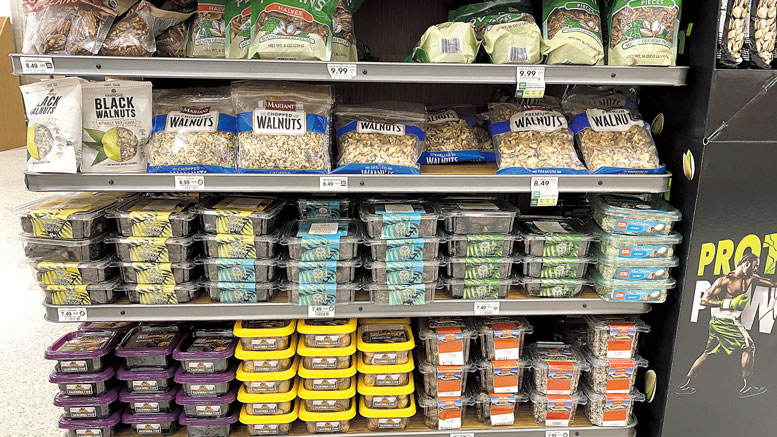Promote Walnuts Year-Round
July 1, 2024 | 7 min to read
Walnuts should be marketed beyond the holiday season due to their versatility and numerous health benefits, as emphasized by experts like Kirsten Holden and Christine Lott. Primarily grown in California, walnuts can enhance salads and snacks, with potential as a plant-based meat substitute. Retailers can boost sales by increasing walnut visibility in produce sections and promoting them alongside complementary foods. Their rich omega-3 fatty acids also support heart health, making walnuts a desirable, nutritious choice year-round.

PRODUCE BUSINESS PHOTO
Pushing walnut sales beyond the holidays can be a win-win for retailers and consumers.
Walnuts are often considered a holiday food, added as an ingredient to dishes and desserts or as a delight paired with nutcrackers and picks. However, their many health benefits, versatility in recipes, and healthy snack opportunities suggest that retailers should be promoting walnut sales all year long.
“Most walnuts in the U.S. are grown in California, where they are harvested in September/October, so historically this led to them naturally being popular in holiday baking and holiday recipes,” says Kristen Holden, senior brand manager at Mariani Nut Company, Winters, CA.
“Thanksgiving and Christmas are the seasons where we see the greatest demand,” agrees Joel Cotrell, assistant produce category manager, Harps Food Stores, Inc., Springdale, AR. “But we’ve found that tying them into other products is a great way to push sales.”
Jacob Basecke, executive vice president, Hammons Black Walnuts, Stockton, MO, says English walnuts, often called California walnuts (juglans regia), and black walnuts (juglans nigra) are popular, and sales can be year-round, but they do tend to be the most popular during the holiday seasons in parts of the Northeast, South, Southeast and Midwest regions.
“We are working to extend walnut excitement and increase purchase frequency year-round by encouraging our retail partners to promote walnuts throughout the year in ways that can inspire shoppers to think of walnuts beyond traditional usage and drive sales,” says Christine Lott, director of integrated communications, California Walnut Board and Commission, Folsom, CA.
“Our research shows that retailers can increase California walnut sales via two core strategies — attracting new users and increasing consumption among current users.”
More than 99% of walnuts in the U.S. are grown in California’s Central Valley, due to the state’s ideal growing conditions in terms of weather, fertile soil, and access to resources. The exception is black walnuts.
“Black walnuts are native to North America, in particular the Midwest, and are sustainably and ethnically sourced from wild, uncultivated trees and hand harvested by local foragers,” says Basecke. “Black walnuts are a tree that a lot of people know of, but may not know that they can eat.”
VERSATILITY OF WALNUTS
Walnuts eaten around the holidays are often sold in-shell, along with decorative nutcrackers and picks. But the in-shell option is declining, and today’s walnuts are usually sold shelled and in a variety of sizes such as whole, halves, pieces and chopped. Shelled walnuts make them easier to eat, which helps retailers to increase walnut sales.
“Research shows that most consumers know walnuts are some of the healthiest nuts, but they don’t know what to do with them, unlike say, almonds, hazelnuts, cashews and pecans,” says Holden of the Mariani Nut Company. “Therefore, it is important for retailers to educate customers on their versatility.”
For one thing, bite-sized walnuts make a hearty topper on salads, a delicious and nutritious addition. “Premium salad kits from manufacturers such as Taylor Farms, Love Beets and Josie’s Organics showcase the appeal of walnuts on salads,” says Lott of the California Walnut Board.
Holden agrees. “On top of salads, in trail mixes, on oatmeal or on cereal are all great ways to incorporate walnuts into your diet.”
Holden says there has been some experimentation with flavored walnuts, with limited success, compared to almonds, “but it is early in the experimentation.”
Harps Food Stores sells candied, chocolate, honey roasted and raw walnuts, and Cotrell believes the versatility of walnuts will increase its popularity among consumers.
“Walnut offerings are now including flour options as substitutes for wheat or corn flour, which could be helpful for those consumers who have a gluten allergy or are watching their carb intake. We’re also witnessing an increase in popularity with candied walnuts as a delicious snack,” he says.
Lott says California growers and handlers are developing flavored walnuts in sweet, savory and spicy flavors to follow the trend of nuts as a healthy snack option. “Retailers are excited about flavored walnuts.”
Lott says another new use for walnuts is as a meat substitute in dishes, such as walnut “meatballs,” walnut “chorizo,” or plant-based burgers.
Basecke, of Hammons Black Walnuts, says black walnuts are darker than English, or California-grown, and are smaller due to the hard, thick shell. “Retailers should stock both, since many consumers may not be aware of their differences.”
Lott says California walnuts are known for their “buttery richness, sweet and mild umami flavor and pleasing texture. Their subtle nuttiness, gentle crunch, and buttery texture pair well with just about anything.”
“Walnuts pair fabulously with so many foods, adding a unique flavor along with a delightful crunch in yogurt, oatmeal, trail mixes, ice cream, salads — you name it.”
— Jennifer Olmstead, California Walnut Board and Commission, Folsom, CA
Jennifer Olmstead, senior director of U.S. marketing and communications, California Walnut Board and Commission, agrees with her colleague. “We’re focusing on summer snacking and how consumers can integrate walnuts into their various activities. Grab-and-go bags make it easy, as does new flavor options,” she says. “Walnuts also pair fabulously with so many foods, adding a unique flavor along with a delightful crunch in yogurt, oatmeal, trail mixes, ice cream, salads — you name it.”
HEALTH BENEFITS
Many of today’s consumers are searching for ways to add healthier choices to their diets. Retailers can tap into this desire by posting signage and providing recipe cards that explain the many health benefits of walnuts.
“They are rich in omega-3 fatty acids, which benefit heart and brain health, and they have antioxidant properties,” says Cotrell. “In the health-conscious world we live in, telling that story is important.”
The California Walnut Board and Commission is looking into the impact walnuts have on cognition and whether they prevent cognitive decline. The commission has also seen potential improvements walnuts have on depression, gut health and sleep.
“The omega-3 ALA is an important feature of walnuts that retailers should point out,” says Olmstead. “You can only get ALA through food, but very few foods provide it. We’ve been doing research for over 30 years, particularly in the area of heart health, and we have a qualified health claim from the FDA on cardiovascular benefits of walnuts. In fact, walnuts also carry the American Heart Association’s Heart-Check mark because of that.”
Basecke, of Hammons Black Walnuts, adds black walnuts have 57% more protein compared to English/California walnuts, and the highest protein of all nuts. “Black walnuts are also loaded with antioxidants, polyunsaturated fats and phenolic compounds.”
He says retailers should partner with dietitians to help educate consumers on the health benefits of black walnuts, and walnuts in general.
INCREASE SALES
Walnuts are typically only purchased when they’re on a shopping list, says Lott.
“In other words, walnut sales are usually planned. The problem is, walnuts are usually not front and center in the consumer’s line of sight, so retailers need to make sure walnuts have greater visibility in the produce department rather than just on the nut aisle,” she adds. “Cross-merchandising them with fresh fruits and vegetables and other products is a great way to inspire shoppers with meal ideas that can lead to incremental purchases.”
Olmstead says the board has seen a lot of success in the produce department when walnuts are displayed near complementary foods such as the banana table, or in bins in front of apples, or near the dates, or cross-merchandised with salad mixes.
“In fact, research indicates that shoppers are inclined to add fresh produce to their carts when they purchase walnuts.”
Harps’ Cotrell suggests placing walnuts with berries on a smoothie display or displaying walnuts with apples and salad mixes.
Lott agrees. “There’s great value for retailers in cross-promoting walnuts in the produce department with other produce items such as berries, dates, apples and pears. Also, bundling offers and offering recipe suggestions can lead to a great ring at the register. In fact, when walnuts are in the shopping cart, it usually correlates to an increase in produce purchases.”
Providing recipe cards or QR codes on signage for online recipe ideas can take the guesswork out of how to incorporate walnuts into meal planning.
“Whole Foods Market’s Trends Council named walnuts as an emerging protein-forward meat alternative in its 2024 top 10 food trend prediction list,” says Olmstead. “At California Walnut Board and Commission, we can help retailers market plant-forward ingredients with a range of resources, including recipes that can be shared on social media, in-store culinary demonstrations and more.”
14 of 16 article in Produce Business July 2024

